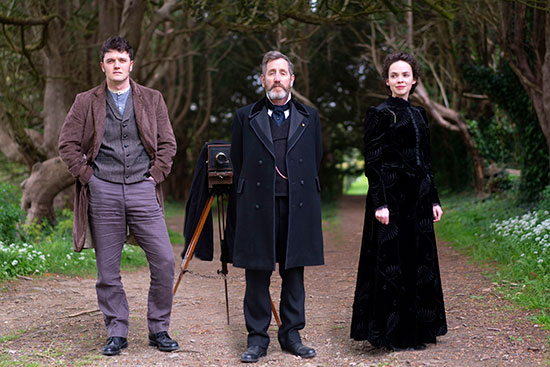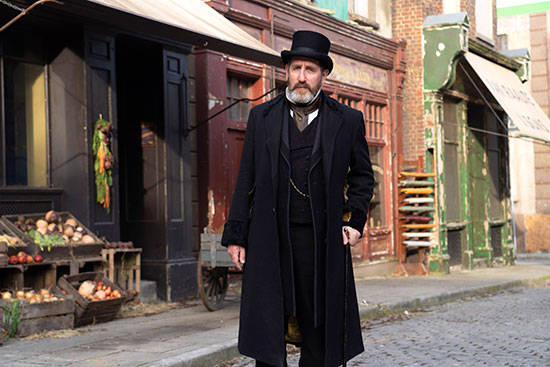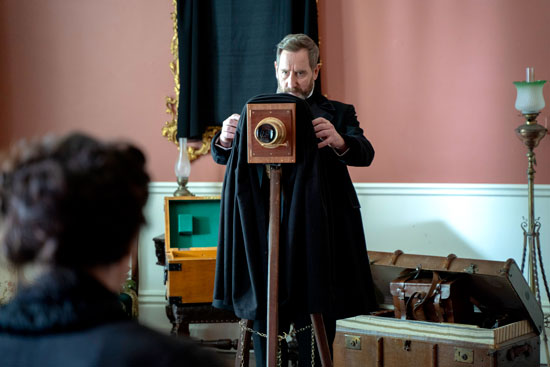The culture around mourning changed significantly in the Victorian era, and one of the practices that now seems particularly odd – photographing the recently deceased – was a common way the Victorians softened their grief.

To help keep this site running: Willow and Thatch may receive a commission when you click on any of the links on our site and make a purchase after doing so.
The increasing popularity of the daguerreotype, and other photographic techniques, allowed families a financially viable way to have a likeness made of the loved one. Post-mortem photography often provided the only visual record of a person.
As the BBC writes: “In images that are both unsettling and strangely poignant, families pose with the dead, infants appear asleep, and consumptive young ladies elegantly recline, the disease not only taking their life but increasing their beauty.” History.com reminds us that for the Victorians ,“taking a photo of a dead body wasn’t creepy—it was comforting.” But add in murder, and the story of the mourning ritual takes on a grisly twist.
Michael Smiley (Death and Nightingales), Kerr Logan (Alias Grace), Eileen O’Higgins (Brooklyn), Aidan O’Hare (The Wind that Shakes the Barley), and Mark Rendall (Versailles) star in “Dead Still,” a new Victorian era series blending murder mystery and drama with delightfully macabre humor.
Acorn Media Enterprises and RTÉ (the national public service media of Ireland) partnered to commission the six-episode Victorian era period drama filmed in and around Dublin.
Set in 1880s Ireland in the heyday of postmortem photography, the story follows a renowned memorial photographer Brock Blennerhasset (Smiley) as he and his loyal assistant Conall Molloy (Kerr Loganthey) visit grieving families for photo assignments, while a tenacious detective investigates a series of local murders and eyes possible disturbing connections between them and Brock.
When the murders escalate, Detective Frederick Regan (O’Hare) of the Dublin Metropolitan Police suspects that Ireland may have its first serial murderer at large. As Blennerhasset becomes a possible suspect and his family is put in harm’s way, they must track down the serial killer before he strikes again.
Below, we talk with series writer John Morton about the upcoming period drama. “Dead Still” may be the next favorite for fans of Vienna Blood, Ripper Street, Penny Dreadful and The Alienist. If Murdoch Mysteries is more your pace, you’ll still want to give it a try; there’s plenty of lighthearted humor in “Dead Still.”
“Dead Still” is streaming on Acorn TV with an exclusive premiere in U.S. & Canada on Acorn TV on Monday, May 18, 2020 with 2 Episodes, followed by weekly episodes Through June 15.
Watch the TRAILER after the interview.

WAT: Am I correct that this is your first period drama? Did the project involve more research for you than others?
JM: Yes, it’s my first time doing a period drama so there was a lot more research than I’d probably undertaken on anything before. Victorian Ireland isn’t readily featured in a lot of fiction so it’s not an era that’s been represented a lot. So I did a lot of research into what was happening at the time but particularly, where technology was at. Dublin had a wide range of photographic studios at the time and it was quite a competitive industry. There was a lot of licence to create this imagined Dublin of 1880 and use real history to illuminate it. Similarly with post-mortem photography, it’s still mysterious in a lot of ways so there was room to interpret how people might have approached it. I’m trying to keep the show as historically accurate as possible but I’m not being slavish to it. On the whole, a good chunk of it was devoted to looking at dead bodies and a lot of questionable Victorian photography!
WAT: Can you tell us a little about the storyline, and what inspired you to write about the Victorian era practice of memorial portraiture?
JM: “Dead Still” is about a renowned memorial photographer Brock Blennerhasset (Smiley) just as that particular photographic fad is on the way out. He’s a reclusive, private man who due to an injury is forced to take on an assistant called Conall Molloy (Logan) as well as have his estranged niece Nancy Vickers (O’Higgins) help run his business. From here, their work becomes intertwined with a suspected serial murderer who may be photographing the deaths of his victims. I was fascinated by the practice of memorial photography when I came across it some years ago. It’s a very morbid concept, almost comically so at times, looking at the lengths people would go to in order to make a loved one look alive for a photograph. But there’s also something quite poignant about it. So that felt like a good mix of tone for a show. It’s a world I’d never really seen explored before. I was fascinated by the origins of crime scene photography and the two things dovetailed quite well historically in the 1880’s.
WAT: How did you balance keeping the script true to the era, while appealing to modern audiences?
JM: It wasn’t easy, nor am I sure I’ve entirely pulled it off! What was useful for me was to present the characters in as close to a modern context as possible because so much of what I’m writing about is applicable to nowadays. It’s about technology changing faster than anyone can anticipate and people who harness that technology for different ends, both good and bad. So in the 1880’s, cameras are becoming more affordable and commonplace and it’s really not unlike how mobile phone technology moves so quickly and how people can use it to communicate, document or express themselves. So that created more similarities between the modern world and this world. I kept the dialogue as close to modern vernacular as possible without trying to sound anachronistic. In as much as possible, they talk like we talk which I think will help modern audiences. And I wasn’t interested in making a show that sounded ‘period’ or had connotations of stiffness or formality. Particularly being in an Irish setting I wanted to hear something that sounded a little more casual than what you might be expect from dramas set in this era.
WAT: One of the “Dead Still” directors, Craig David Wallace, has worked on “Murdoch Mysteries.” The long-running period series also involves murder mystery solving in the late 1800s. Should viewers expect some similarities in the shows, or do the comparisons end there?
JM: I think you’ll certainly see some similarities, “Dead Still” is similarly rooted in that world of Victorian crime fiction and I haven’t shied away from utilising a lot of the iconography associated with that style. I’m a big fan of that kind of work so I definitely wanted to make “Dead Still” chime with that. I’m also weaving it around real history like Murdoch Mysteries does but in the first series, we stop short of introducing any historical figures. There are a few mentioned so I’m definitely keeping those ideas in play for future potential use. And a relationship to real history can be useful for grounding the story for an audience. “Dead Still” is a bit of a stew of those murder mystery influences, elements of Irish mythology, folklore and history and a lot of Victorian death culture. Both shows put a keen focus on crime scene investigation too and certainly it’s something we’ve planted in the first series of “Dead Still” to develop further.

WAT: “Dead Still” blends mystery and drama with gallows humor. Does this mean things don’t get too dark, even though the narrative concerns portrait photography of the recently deceased, a string of murders, and a serial killer?
JM: It gets pretty dark! The overarching plot of the series is about a serial killer implementing a very early progenitor of the modern concept of ‘snuff photography’ so it’s definitely not all sweetness and light. And I didn’t want to make those elements feel too comic. It’s very much morbid, gallows humour and I’ve tried to keep a good sense of absurdness to the series but it’s predominantly got to function as a murder mystery. In real life things can get serious or absurd, often all at the same time so the show tries to represent that!
WAT: Most of the stars in “Dead Still” are experienced period actors, used to slipping into another era. What is it like to see your vision of the Victorian period come to life?
JM: It’s been pretty astonishing to be honest. I had a bit of a jolt when I first saw the rushes. It just kind of hit me “Oh yeah, of course it’s a period show”. I never really thought of it in those terms but when you see it coming to life it really hits home. It’s very cool seeing how the characters are being embodied by the actors. We’re trying to create a really rich and vibrant world, the kind of richly populated feel of a Joyce novel or a Sherlock Holmes story and the actors are adding so much of that colour and flavour.
WAT: How did your script influence the costumes and set design?
JM: I guess everything is jumping off the script but just seeing how the crew have interpreted it has been kind of mind blowing. Each character looks and feels very distinctive. And the sets are just wonderful, they’ve created a very rich and layered world for the show. I’m an absolute sucker for detail and seeing the effort put into every shot has been a real joy for me.
Watch the trailer below.
“Dead Still” premieres in 2020 in Ireland and on Acorn TV in the United States in May, 2020 as an Acorn TV Original. Acorn TV streams world-class mysteries, dramas, and comedies from Britain and beyond. Also available as an add-on channel with Prime Video.
If you enjoyed this post, be sure to see The Period Films List, with the best British, historical and costume dramas sorted by era. Be sure to see the list of Period Dramas on Acorn TV in 2020. You’ll also like our review of BBC’s Quacks, and the Best Period Dramas: Victorian Era list, and our list of period dramas that deal with Life After Loss. 

W P Jones
July 25, 2023 at 2:00 am (2 years ago)I watched and enjoyed the series, however as a collector of antiquarian photography for over 30 years I can say Victorian PM photography was hardly commonplace, in fact it was rare, which is why genuine period PM images are so scarce to find. Further, if you have ever handled corpses, and I did as a military medic, you would know that posing the dead weight of bodies proves very difficult, especially after the initial rigor mortis wears off. So from both an historical and scientific perspective the series is over the top.
cory
June 10, 2020 at 12:01 pm (5 years ago)I love Dead Still, I just wish they didn’t have to use the F word so much. Was it really used that much in Victorian Ireland?
Willow and Thatch
June 10, 2020 at 2:46 pm (5 years ago)I remember reading an article about how swearing was such a part of different eras, and while I don’t specifically remember about the F word in the Victorian era, it’s likely it was common. Still, this is one area where I’d prefer some historical inaccuracy. I too, can do without it!
Kim Bloomer
May 20, 2020 at 2:36 pm (5 years ago)Already hooked and love Dead Still!! Finally another period series full of dry humour. Love the main character. Thank you Acorn! More like this. Historically very interesting and informative.
Laura Brittain
July 4, 2019 at 3:51 am (6 years ago)More, please